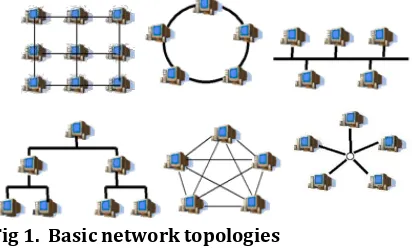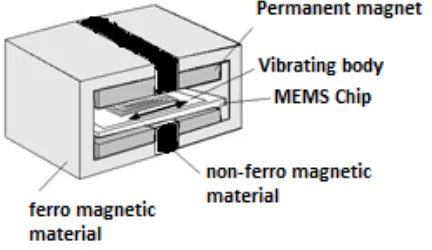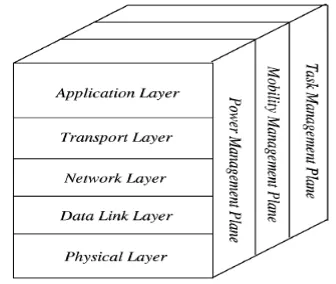Contents lists available a
Asian Journal of Computer Science and Information Technology
Journal homepage
Review
WIRELESS SENSOR NETWORK
Ajita Pathak , Vertika Sarkari
Department of Electronics& Communication Engineering, Amity School of Engineering & Technology, Amity University Uttar Pradesh, Lucknow.
ARTICLE INFO ABSTRACT
Corresponding Author:
Ajita Pathak
Department of Electronics & Communication Engineering, Amity School of Engineering & Technology, Amity University Uttar Pradesh, Lucknow. India.
Keyword: Wireless Sensor Network; Ad hoc Network; protocol stack; MEMS Power generator; OSI Model; Medium Access Control (MAC)
DOI:
Wireless sensor networks (WSNs) are very popular technology to sense the environment and report what happens in the area where it is deployed. In this paper we discuss the WSN architecture according to OSI model and describe the concept of sensor network which has been made viable by convergence of micro electromechanical system technology, wireless communication, and digital electronics. This paper outlines the power management / power generation and applications of sensor network.
©2014, AJCSIT, All Right Reserved
INTRODUCTION
Over recent years of research, the advancement of micro-electro mechanical system (MEMS) technology, wireless communication, and digital electronics have enabled the development of low cost, multifunctional nodes which have computing power and can transmit/receive message over communication links. [1]
A specific node, called sink is in charge of collecting and a large number of battery powered sensor nodes that have the ability to sense the physical environment, compute the obtained information and communicate using the radio interface. Because the sensor node are generally deployed on a large and wild area, they are powered by battery and it is difficult to charge or recharge the battery, thus to reduce energy consumption and to extend the lifetime of WNS are very important points. In order to extend the lifetime, sensor node transmits packets with low transmission power (0 dBm).With this transmission power, a packet can only be transmitted dozen of meter away in one hope. Therefore a packet from a source node in WANs will be sent to a sink node in a multi hop, ad-hoc network.
That is the wireless sensor network is an emerging application area for ad-hoc network which has been received unprecedented attention. The main idea is to use a collection of cheap to manufacture, stationary, tiny sensors to sense, and coordinate activities and transmit the physical characteristics about surrounding environment to an associated sink node. Once placed in a given environment, these sensor remain stationary, with power remaining a
major driving issue behind protocols tailored since lifetime of the battery usually defines the sensors lifetimes.
Since many protocols and algorithms have been developed for traditional wireless ad-hoc networks, they are not desirable for unique feature and application requirement of sensor network. To illustrate this point, the difference between sensor and ad-hoc network has been already outlined [1].
NETWORK TOPOLOGY
One of the most important constraints on sensor node is its low power consumption requirement. Sensor nodes carry limited, generally irreplaceable, power source and networks life is as long as of power supply. The basic issue in communication networks is the transmission of messages to achieve Quantity of Service and Quality of Service (QoS) along with power conservation. [1]
Fig 1. Basic network topologies
fully connected, & star respectively. Networks are further classified as Local Area Networks (LAN), used inside one building, or Wide Area Networks (WAN), used between buildings.
Mesh networks are regularly distributed networks and transmission is only between a nodes’s nearest neighbours. The nodes in these networks are generally identical. Mesh nets can be good models for large-scale networks of wireless sensors that are distributed over a geographic region, e.g. personnel or vehicle security surveillance systems. An advantage of mesh nets is that, although all nodes are identical and have the same computing and transmission capabilities, certain nodes can be designated as ‘group leaders’ which are capable to take additional functions. If a group leader is disabled, another node can then take over these duties.
In the ring topology all nodes perform the same function and there is no leader node. Messages travel around the ring in a single direction.
The bus topology is passive i.e. each node simply listens to the messages and is not responsible for retransmitting any messages which are broadcast on the bus to all nodes. Each node checks the destination address in the message header, and processes the messages addressed to it.
In star topology all nodes are connected to a single hub node.
The hub possesses greater message handling, routing, and decision-making capabilities than the other nodes. If a communication link is cut, it affects only one node. However, if the hub is incapacitated the network is destroyed.
POWER MANAGEMENT/GENERATION
It is known that power consumption is the main constraint on the sensor network, there is a focus on increasing the lifetimes of sensor nodes through power generation, power conservation, and power management. Now a day, research is in designing small MEMS RF components for transceivers, including capacitors, inductors, etc. Micro-sized inductors are a challenge in this area. MEMS power generating device is developed which vibrates at the frequency of the external vibrating source and create the electoral energy. [2]
Fig. 2 MEMS Power Generator
MicroGen Systems, Inc. (“MicroGen”) provided vibration energy harvesting BOLT™ Power Cells, shown in figure (3), which enabled a live wireless sensor network (WSN) using Linear Technology’s Dust Networks LTC5800-IPM SmartMesh™ IP mote-on-chip. The Linear mote being powered by MicroGen’s piezoelectric Micro Electro Mechanical Systems (piezo-MEMS) vibrational energy harvester.
Fig. 3 Piezo- MEMS Generator
Inside MicroGen’s BOLT Power Cell is a small semiconductor MEMS chip fabricated using similar techniques as that of computer chips. This chip is a ~1.0 cm2
Now a days, TDMA is used for power conservation, since a node can sleep (power down) between its assigned time slots, waking up in time to receive and transmit messages. We know that the required transmission power increases as the square of the distance between source and destination. Therefore, multiple short message transmission hops require less power than one long hop. In fact, if the distance between source and destination is R, the power required for single -hop transmission is proportional to R
piezo-MEMS MPG (micro power generator) containing one end-mass loaded micro-cantilever which possesses a piezoelectric thin film. As the MPG’s cantilever bends up and down due to the external vibrational force it produces alternating current (AC) electricity. At resonance the AC power output is maximized, where it is ~100 microWatts at 120 Hz and 0.1 g, and ~900 microWatts at 600 Hz and 0.5 g. [3] The AC electricity is efficiently converted to direct current (DC) using Linear Technology’s LTC3588-1 piezoelectric energy harvesting AC to DC converter. After the energy is scavenged it is temporarily stored on a 300 microFarad capacitor. The output of the Power Cell ranges from 25-500 microWatts at 3.3 Volts DC, depending upon configuration and frequency.
2. If nodes between source and destination are taken advantage of to transmit n short hops instead, the power required by each node is proportional to R2/n2
ARCHITECTURE OF NODE
.Above argument in favours distributed networks with multiple nodes. [7]
The main focus of the node architecture is to reduce cost, increase flexibility, provide fault-tolerance, improve development process and conserve energy. It consists of sensing unit, processing unit (MCU-micro controller unit), communication unit, and power supply as shown in figure (4) below. [4] [5] [6] [8]
Fig. 4 Sensor Node Architeture
converter (ADC) present there converts the signal. The type of sensor being used in a sensor node depends on the application. Third block is processing block which has memory (RAM), microcontroller, operating system and timer which are responsible for storing, processing and executing the events respectively. Fourth block is communication block that provides communication channel which may use radio, laser or optical and infrared frequencies Last block is software.
Sensing Unit
A/D converter is used for converting the analog signal into digital signal. It takes an analog signal from sensor and converts it into digital signal and relay to microcontroller for further processing.
Processing Unit
It collects data from various sources then processes it and stores it. The central process unit of sensor node determines energy consumption and computational capabilities of a node. In order to provide the flexibility for CPU implementation, large number of micro-controller, microprocessor and FPGAs are also available.
Micro-controller is a general purpose processor used for processing. It is not only consists of memory and processor but also non-volatile memory and interfaces. It helps to reduce the requirement of wiring, extra hardware, circuit board space and energy. Microcontroller should have three states-active, sleeps, idle in order to save power. Timer is a special type of clock. There are of different types of timers such as electronic, electromechanical, mechanical and digital. It has also low volume and low power consumption.
WSN uses less complex operating system as compared to general –purpose operating system. It uses few thousands of lines for coding the system whereas general-purpose consist of millions of lines of codes. Some WSN node operating systems are Tiny OS, Contiki, MANTIS, BTnut and SOS etc. [8]
Here, RAM is used as an internal memory for storing information in microcontroller. We can also use flash memory which is used for storing program code. However, Size of memory can affect consumption of power and cost. Thus, selecting the appropriate size of memory is important and can be selected according to application.
Communication Unit
A Communication unit or a transceiver is a unit in which transmitter as well as receiver is sharing same circuitry on single board. It receives command from processing unit and passes it to the other node of the network. Communication is performed through communication channels. This phase provide some network protocol in order to perform communication. Three types of communication are discussed here–
Optical Communication- An optical communication is telecommunication system in which transmitter convert signal into optical form at sender side and convert optical signal into original signal at receiver side. Advantages of optical communication are that it takes less energy than radio frequency, there is no requirement of antenna, no broadcast is used so no need of security. Disadvantages of optical communication are that it support line-of-sight communication (transmitter must be line up with receiver during communication) and it is sensible to atmospheric conditions.
Infrared-The communication is Omni directional within plane but every time node requires to be aligning within a
plane. It requires no antenna and has short-range of 1m.
Radio-frequency
Software
-It is based on electromagnetic waves which plays an important role in power conservation. It has four operating mode- transmit, receive, idle, and sleep. In order to conserve power, it is necessary to shut down the radio when there is no need, since radios operating in idle mode take power equal to receive mode. Advantages-Easy to use, provide integrity, well established in commercial place. The main challenge in RF is size of antenna. [6]
It provides four services such as
i) sensor manager which provide access to sensors and manage the delivery of sensor data, ii) storage is responsible for providing the persistent storage for data streams, iii)query manager performs query processing and manages active queries, iv) integrity services is used for access control. [5]
SENSOR NETWORK ARCHITECTURE
Most common architecture for WSN follows the OSI Model. Basically in sensor network there are five layers: application layer, transport layer, network layer, data link layer and physical layer. Added to the five layers are the three cross layers planes:power management plane, mobility management plane and task management plane. These layers are used to manage the network and make the sensors work together in order to increase the overall efficiency of the network [1].
Fig. 5 WSN Architecture
their power & task usage. The task management layer balances and schedules the sensing tasks given to a specific region. Since not all the sensor nodes in that region are required to perform the sensing task at the same time. Finally, some sensor nodes perform the task more than others depending on their power level. These management layers are needed so that sensor nodes can work together in a power convenient way, route data in a sensor network, and share resources in between sensor nodes.
APPLICATIONS OF WSNs
Sensor networks consist of very small nodes (sensors) that are deployed in some geographical area. Sensor networks are used to measure temperature or pressure, or it could be used for target tracking or border surveillance [10], natural disaster relief [11], biomedical health monitoring [12,13], and hazardous environment exploration and seismic sensing[14].
It could be also deployed in factories in order to monitor toxic or hazardous materials. It is also used to measure the weakness in building structures, or in vehicles and airplanes. Sensor nodes can be used for continuously sensing, event detection, location sensing, and local control of actuators. The concept of micro-sensing & wireless connection of these nodes promises many new application areas. We categorize the applications into military, environment, health, home and other commercial areas.
Sensor networks consist of many different types of sensors such as seismic; lower sampling rate magnetic, thermal, visual, infrared, and acoustic & radar that are capable to monitor a wide variety of ambient conditions that include the following: [1]
• Temperature, • Humidity,
• Vehicular movement, • Lightning condition, • Pressure,
• Soil makeup, • Noise levels,
• The presence or absence of certain kinds of objects, • Mechanical stress levels on attached objects, and • The current characteristics such as speed, direction, and size of an object.
Sensor usage may be classified in five main categories: Environmental, gas, physical, optical and biometric. [9]
Environmental Sensors: Temperature, Humidity (soil, leaf, ambient), Soil moisture, Wind (speed and direction), Pressure, Leaf, Ph., Redox.
Application:
•Precision agricultural applications are one of the most required in the terms of temperature, humidity (soil, leaf, ambient) and wind (speed and direction).
•Ph. and Redox sensors being demanded for water quality
Physical Sensors: accelerometer, presence, vibration, power, hall, ultrasound, water, sound, bend, flex, strain, stress.
Application:
•Motion of any kind using accelerometers, vibration, and presence sensors.
•security applications are waiting to be deployed.
•world of objects: bend, flex, strain and stress sensors let know how each object is interacting with the world and monitories its state.
Gas Sensors: Co2, Co, CH4, O2, NH3, SH2, NO2, Pollution. Application
•Organic gases (Carbone) derived from the "live systems" such as respiration in humans (CO2), animals (CH4) and combustion (CO) of vegetable elements (fire forest) are the most required sensors.
•Other toxic gases which can be found in animal farms (NH3, SH2) and the fabric and cars pollution gases (NO2) complete the list.
Optical Sensors: Infrared, Sunlight, Radiation, Ultraviolet, colour
Application
•Optical sensors to detect human presence through the IR spectrum are the most voted sensors in this area.
•Agriculture applications where the sun light, radiation and ultraviolet sensors are required in order to measure the total amount of energy and light which is absorbed by the plants.
Biometric Sensor: Electrocardiogram ECG, Oximetry, Pulse, fall, Sweat
Application:
•Prevent a possible attack or the fall of a elderly person (using an accelerometer) by monitoring his heart pulse, rate and other heart activities. Used in combination of SMS alarms using the GSM/GPRS module
•Requirements: a real time and redundant alarm system so that communication can always be established.
CONCLUSION
This paper elaborates the characteristics and functioning of each module of node architecture as well as of WSN architecture. The flexibility, fault tolerance, high sensing fidelity, low cost, and rapid deployment characteristics of sensor networks create many new and exciting application areas for remote sensing. In future, these wide ranges of application areas will make sensor networks an integral part of our daily life. In essence, sensor networks will provide the end user with intelligence and a better understanding of the environment. Although a great work has been done in relation with wireless sensor networks, till date and but still many efforts and research work is needed in the direction of design and security of WSN.
REFERENCES
[1] Akyildiz, I.F., Su, W., Sankarasubramaniam, y., Cyirci, E., Wireless sensor networks: a survey. Computer Networks, Vol. 38 no.4: p. 393-422, 2002.
[2] F.L LEWIS”wireless sensor network”, aro research grant daad 19-02-1- 0366, in newyork 2004
[3] Rochester, NY (PRWEB) June 25, 2013
[4] Ajay Jangra, Richa ,Swati,Priyanka, “Wireless Sensor Network (WSN): Architectural Design issues and Challenges”, et al. / (IJCSE) International Journal on Computer Science and Engineering Vol. 02, No. 09, p : 3089-3094, 2010
[5].Mi Li and Tony Lee,”ppt on middleware for sensor network”
[6] Macros Augusto m. Vieira, Diogenes Cecilio da Silva Junior, ”Survey on wireless sensor network devices” cpna 2002- 2009.
[7] P.R. Kumar, “New technological vistas for systems and control: the example of wireless networks,” IEEE Control Systems Magazine, pp. 24-37, Feb. 2001.
[8]
[10] I.F. Akyildiz and W. Su and Y. Sankarasubramaniam and E. Cayirci, "A Survey on Sensor Networks", IEEE Communication Magazine, vol. 40, no. 8, pages 102-116, Aug. 2002.
[11] M. Castillo-Effen, D.H. Quintela, R. Jordan, W. Westhoff, W. Moreno, Wireless sensor networks for flash-flood alerting, in: Proceedings of the Fifth IEEE International Caracas Conference on Devices, Circuits, and Systems, Dominican Republic, 2004.
[12] T. Gao, D. Greenspan, M. Welsh, R.R. Juang, A. Alm, Vital signs monitoring and patient tracking over a wireless network, in: Proceedings of the 27th IEEE EMBS Annual International Conference, 2005.
[13] K. Lorincz, D. Malan, T.R.F. Fulford-Jones, A. Nawoj, A. Clavel, V. Shnayder, G. Mainland, M. Welsh, S. Moulton, Sensor networks for emergency response: challenges and opportunities, Pervasive Computing for First Response (Special Issue), IEEE Pervasive Computing, October– December 2004.
[14]G. Wener-Allen, K. Lorincz, M. Ruiz, O. Marcillo, J. Johnson, J. Lees, M. Walsh, Deploying a wireless sensor network on an active volcano, Data-Driven Applications in Sensor Networks (Special Issue), IEEE Internet Computing, March/April 2006.


